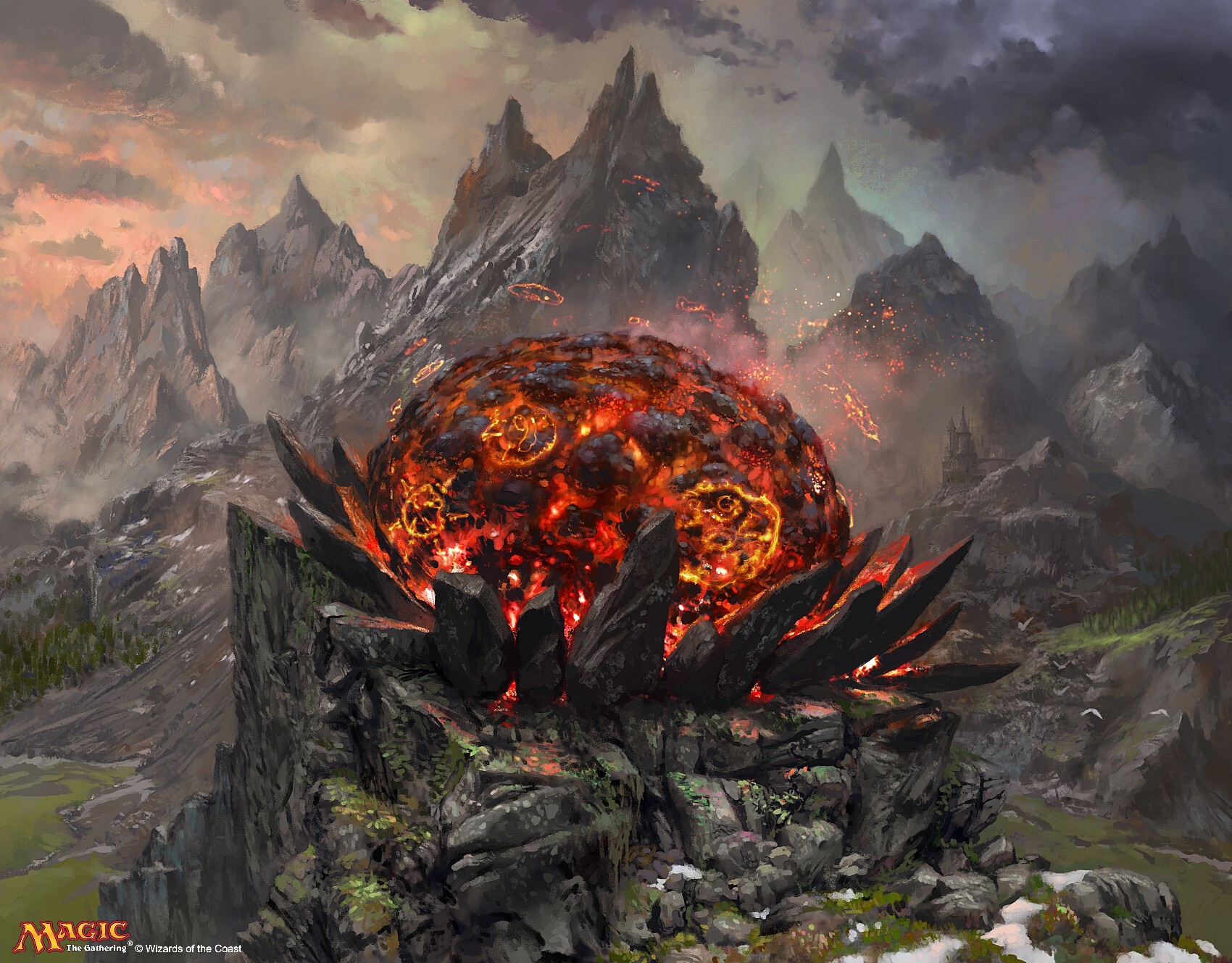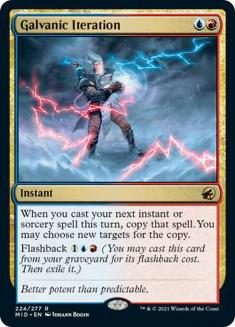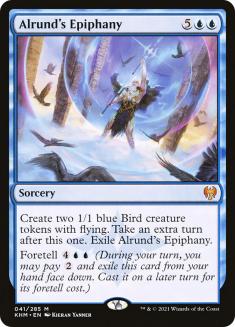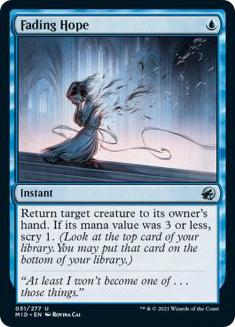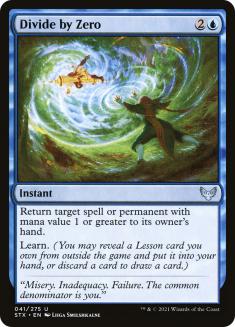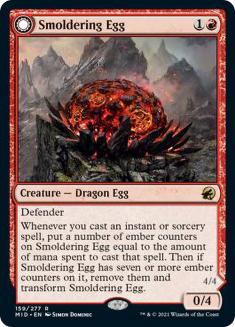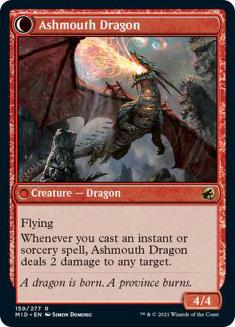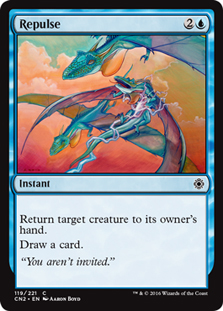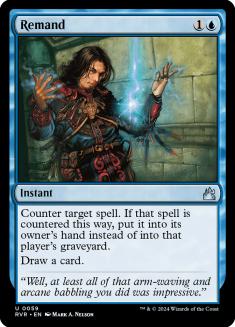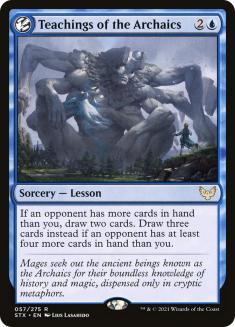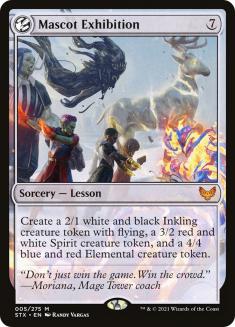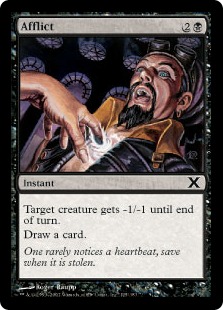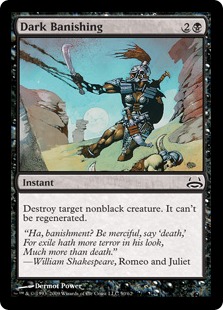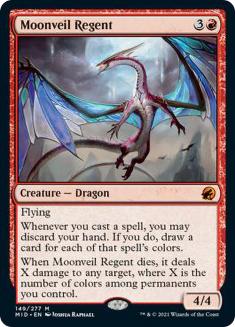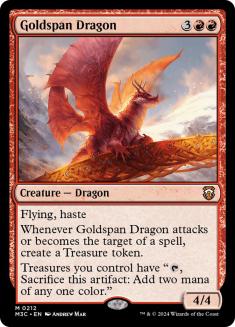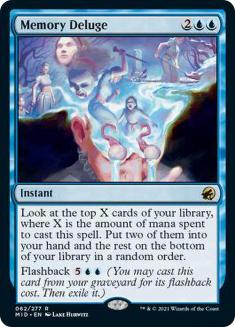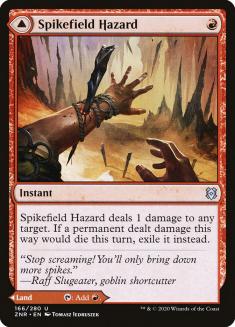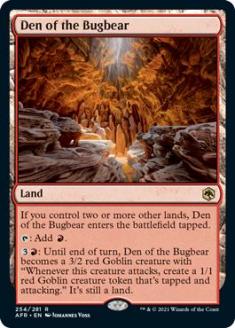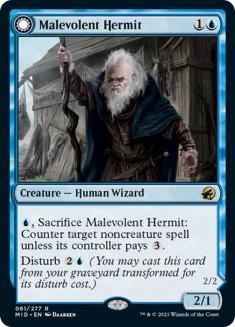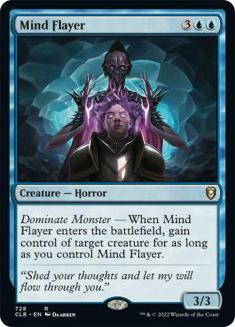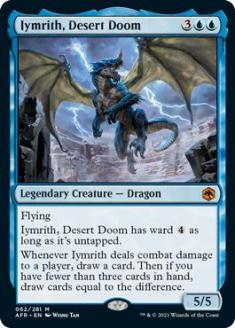Izzet Control featuring Goldspan Dragon has been a Standard staple for a while now. Having that burst of mana specifically give you two mana on the turn you cast Goldspan Dragon means you’re guaranteed two mana from it attacking or it being targeted by an opposing removal spell. In either case, you will be able to stifle your opponent’s interaction or development on the following turn with some manner of counterspell or removal.
With the release of Innistrad: Midnight Hunt, a lot of powerful stuff rotated and has left room for new decks and archetypes to show up. I’ve been experimenting with a few different builds of Izzet in the hopes that something would stick. Wyatt Darby played a cool “Turns Combo” involving this little pair, and I thought it was worth a try.
This build was pretty cool, allowing you to take four or more turns in a row sometimes, making Birds all the while. There were a few too many spots where Galvanic Iteration didn’t quite do enough, and more points still where I would cast Alrund’s Epiphany, sometimes multiples, and lose. Time Walk effects are strengthened by cards already on the battlefield. If you cast a Time Walk without pressure or some way to gain a micro-advantage, what are you actually gaining? Some mana from the rest of the lands after you’ve cast the Time Warp? In essence, Alrund’s Epiphany can be lackluster if you don’t pair it with permanents that gain micro-advantages. That’s why I moved on.
Izzet Dragons is a deck I’ve seen a few people have success with as of late, but I just couldn’t put my finger on why I didn’t like their builds. Frost Bite and other spot removal seemed fine, but too many threats just slipped by. I liked Smoldering Egg but couldn’t would often run out of stuff to cast. The one thing I loved about Wyatt Darby’s version of Izzet was how the interaction package he chose wasn’t reliant on killing the creatures outright, and instead was more focused on bouncing stuff to create little pockets of time.
This pair was so much better than I originally expected. They don’t actually kill the opposing creature, but they bought us time to start casting Alrund’s Epiphany. Bounce spells are often accompanied by cheap threats that you can use to pressure the opponent. That means you’re spending less mana to deal with the problem, but you’re not actually handling it permanently. Forcing your opponent to spend more mana than you to cast their threat than you do to cast your answer is the essence of “tempo,” or creating pockets of time where you have full advantage over the battlefield or life totals at the cost of card advantage.
Tempo is often discussed improperly, and decks are labeled incorrectly as such. If you have a Delver of Secrets on the battlefield and then cast Fading Hope to bounce your opponent’s creature, you’re creating a little pocket in time where your creature can deal damage uncontested. You’re doing this at the expense of “one physical card” of “card advantage,” but you’re just sacrificing card advantage for time advantage. This deck, Izzet Dragons, is the epitome of tempo, and exemplifies everything it means to trade down on resources in order to pressure the opponent. If you have a spell like Alrund’s Epiphany that can end the game when cast, all you need is a little time.
After playing with Wyatt’s version, I noticed his lack of threats made Alrund’s Epiphany less of a “game over” and more of a “tread water and make a few blockers.” Sure, it would still win the game if cast in multiples, but the true power of that kind of spell is casting it with Goldspan Dragon or similar already on the battlefield. After figuring out that the removal was the bad part of Izzet Dragons previously, and bounce spells were needing a good creature package, I just smooshed the two together and came up with something wonderful.
Creatures (12)
Lands (18)
Spells (30)

An Egg In These Trying Times
The strongest addition to this archetype is Smoldering Egg, but everyone I know calls it Thing in the Egg, and I often forget what it’s actually called so I usually just call it Egg. Regardless, Smoldering Egg is similar to Thing in the Ice in many ways. It plays defense early, transforms relatively easily, and threatens to dominate the battlefield once you do. I was expecting Smoldering Egg to be solid, but it ended up being far stronger than I could have imagined. It was pretty easy to transform, and Ashmouth Dragon was an absolute monster.
The trick to any card like Smoldering Egg is figuring out what to surround it with. Egg specifically doesn’t care about raw number of cast instants and sorceries, and instead just goes with the flow and transforms when you’ve spent seven mana. That means the spells you cast to turn it on can be efficient, but don’t needlessly have to be cheap. That means a three- or four-mana spell is usually pretty good to pair with it, because that allows you to transform it somewhat easily after casting it on the second turn. If those two cards cast are interactive, you can usually bank on gaining an easy foothold on the game. If your opponent can’t kill Ashmouth Dragon, they’ll be dead in a hurry.
The one card I’ve been fawning over since playing the Wyatt Darby version of the deck also just so happens to be unreal with Smoldering Egg.
Divide by Zero is not a new card, but it’s an underutilized one. To be frank, I never actually cast the card before a few days ago. I’ve been mostly focused on Modern as of late, so you can imagine my surprise when a good Draft uncommon became one of my favorite cards in Standard. Allow me to explain a bit further.
Divide by Zero is a lot like Repulse, in that you can bounce a creature and gain a little bit of card advantage out of it. Learn might not be as good as “draw a card,” but building your deck to utilize Lessons has become somewhat common as of late. Lessons are pushed to their apex when combined with Smoldering Egg, because they’re a little overcosted compared to normal spells. As a result, we’re actually kinda reducing their cost in a virtual way by pairing with Smoldering Egg, because we’re actually rewarded instead of punished by these cards having a slightly higher mana value than normal.
Divide by Zero is also a lot like Remand in that it can interact with a spell on the stack, resetting it back to your opponent’s hand, and drawing a card off it. As with the Repulse analogy, the actual card drawn is probably worse than one from your deck, but making it better by pairing it with Smoldering Egg means it will rarely be bad.
So one half of Divide by Zero is like Repulse, and the other half is like Remand. That sounds like one hell of a card when you can make Lessons into real spells. Figuring out how many and which Lessons to put in your sideboard is key, but I’m under the impression that most people play far too many. I saw a version that was pretty light, with only four or five, but I figured I could push it even further. I went with three.
Environmental Sciences is pretty cheap, and pairs nicely with your two-mana interactive pieces on the fourth turn. Finding this from Divide by Zero is the most common, because it allows us to cast it and find that crucial fourth land on the fourth turn while still holding up mana. It’s the most common one found because it’s the cheapest, and requires the least amount of work to make useful. The two life you gain is actually somewhat relevant in a number of aggro matchups as well.
Alongside Divide by Zero and Fading Hope, you actually put quite a few cards back in your opponent’s hand. Because of this, you’re going negative on card advantage over time, which means a little refresher like Teachings of the Archaics can be just what the doctor ordered. Because we’re playing Smoldering Egg, we can empty our hand of cards pretty quickly as long as we don’t get flooded too badly.
While this one is the most inherently powerful of the bunch, it’s also the most expensive. If the game has gone late, Mascot Exhibition is one of the easiest grabs in the world because it gives you a burst of pressure or defense when you’ve entered the late-game. It’s also a pretty good precursor to Alrund’s Epiphany, giving you a tremendous battlefield presence before taking that extra turn.
These three are my picks for the only ones you should be playing in this deck, but I wouldn’t fault you for playing one more. Your sideboard slots are somewhat valuable, so tightening up that tutor package is paramount if you want to have enough slots for some of your tougher matchups.
The Illusion of Card Advantage
Card advantage has long been an important part of understanding and exploiting specific Magic formats. The idea is clean: if you go down a card in an exchange, you have interacted unfavorably. Any spell that says “draw a card” usually has a weaker effect than a one-and-done.
In the past, “draw a card” was usually added to weak spells to create some tension in Limited. You want minor effects that keep the gas flowing because you’re always at risk to flood out or mana screw. In Constructed, you can build your deck in some ways that reduce the risk of flood or screw, so you see fewer Afflicts and more Dark Banishings.
As time went on, Wizards of the Coast (WotC) randomly decided that “draw a card” was a staple effect they could add onto any card they wanted to make better. I think about 1/6 or so of Throne of Eldraine cards say “draw a card” or replace themselves in some way. When you go from Afflict / Dark Banishing to Omnath, Locus of Creation, your understanding of card advantage and normal game theory has to be reimagined.
This same thing happened in Hearthstone. I remember playing it years ago where combat actually mattered. Every time I tune into a big Hearthstone event these days, every single turn seems to be “clear your opponent’s side of the battlefield and present pressure for them.” If you failed to do exactly that every turn, you usually ended up getting snowballed. The same has happened to Magic over the last five years or so, where you needed to clean up your opponent’s side of the battlefield and present some major aggressive force to gain an advantage. Planeswalkers are a living example of this effect, as a planeswalker that sits on the battlefield for more than a single turn often gains too much of a battlefield advantage and virtual card advantage to overcome.
Since everything draws a card, flooding out is no longer likely, and sometimes almost impossible. That means we’re all resource-flooded, so the cheaper option that loses a card on interaction is no longer bad, but somewhat flipped. That’s why Divide by Zero is better than Saw It Coming, and Fading Hope is better than Frost Bite. Permanently dealing with your opponent’s stuff is no longer imperative. You just need to stall it out long enough for your own overpowered stuff to take over the game.
Counterspells are often excellent in formats like this one, where so many cards replace themselves and decks never run out of things to do. Counterspells stopping something before it happens means it can’t replace itself. Disdainful Stroke and Negate aren’t often maindeck-playable, but that all changes when every deck jams powerful planeswalkers and end-game threats on the fourth or fifth turn. Using that cheap piece of interaction to stop your opponent in their tracks also frees up some mana so you can cast another spell in the same window. When you trade two mana and one spell for four or more mana and one spell, you’ve essentially created an uneven mana exchange that you can exploit.
If you create enough instances of this type of exploitation, you can find a window to resolve Alrund’s Epiphany and close the door. That’s creating time. That’s tempo.
With that said, some removal, if efficient, is still worthwhile. Of all the options in Standard, my favorite has been Dragon’s Fire when we play more than Goldspan Dragon. Being able to deal four or five damage to an opposing creature for two mana often allows us to kill creatures more expensive than our piece of removal. That is ultimately the goal when it comes to spot removal: dealing with a problem for fewer resources than the opponent invested. That’s why Swords to Plowshares is so good: efficiently answering just about anything, and the only reward you give to the opponent is some life points. In Magic, life points are one of the least valuable resource points because the only one that matters is the last one. If you’re a control deck, you rarely care about your opponent’s life total, making cards like Swords to Plowshares that much stronger.
Where Are My Dragons?
When we talk about tempo, one important aspect is having some threat or permanent on the battlefield that helps compound your advantage. Taking an extra turn or killing your opponent’s creature or countering their spell is often trading at even resource points. If you have a creature or planeswalker on the battlefield, your trade ends up with you gaining on life by attacking a bit or activating a planeswalker.
These are the threats I’ve chosen, and I’ll list out the reasons below each so you get a better understanding of their roles in this archetype.
Smoldering Egg
- Cheap. At two mana, Smoldering Egg comes down early. In the past, threats like this have made serious waves because they piggyback on efficient interaction without costing a significant amount of mana.
- Easy to transform. Because it scales with mana spent, you can interact at your own pace and transform it in a few turns. You don’t have to flood your deck with cheap interaction because raw spells cast doesn’t matter. Divide by Zero is also outrageous with Smoldering Egg, giving you ways to efficiently use your mana while interacting.
- Defensive. Four toughness and a cheap casting cost mean Smoldering Egg can play defense from some early pressure on the opposing side. If your opponent spends mana in the early turns to kill your Egg, chances are they aren’t applying more pressure, which is also fine. Don’t sleep on this body, and you should usually choose to block when you can.
- Game-altering if left unchecked. Ashmouth Dragon is phenomenal. If you get to transform it, that’s great. If you get to untap with it after it transforms, the game is usually over.
Moonveil Regent
- Efficient. At four mana, Moonveil Regent comes down relatively early and is very threatening for the cost. Flying is a big deal too, making Moonveil Regent one of the most efficiently costed creatures I’ve seen in a long time.
- Spell engine. If you’re low on resources, like playing against an opponent with a bunch of discard spells, Moonveil Regent can turn into a draw engine. I initially didn’t realize this was a “may” ability, which is important to note when many of your cards replace themselves.
- It’s a Dragon. As a Dragon, Moonveil Regent adds another point to Dragon’s Fire, my pick for best removal spell in Standard.
Goldspan Dragon
- Haste. The speed at which Goldspan Dragon can close games is filthy. Haste allows for attacking planeswalkers quickly, but it also means you’re putting Treasures on the battlefield immediately. If you get to attack, and your opponent kills it in the same turn cycle, that often creates enough mana to cast Memory Deluge.
- Snowball effect. If you ever get to untap with Goldspan Dragon, you should usually generate enough extra mana and pressure to take it down. The extra mana from the Treasures means you’ll rarely be stifled on casting your spells. You’ll only be limited by raw cards, which we’ve already deduced are pretty tough to run out of. Thanks to Memory Deluge, Expressive Iteration, and Divide by Zero, you should be able to keep casting spells forever.
We Can Rebuild It
In a Standard Metagame Challenge on Arena, the goal is to get seven wins without a single loss. If you can do it, you are rewarded with 30 booster packs and other in-game assets. Getting seven wins in a row is a tall order, which is why I was surprised at how easily I was able to complete this goal on my first try. Izzet Dragons as I built it felt excellent, but it can be better. Let’s go over some of my concerns and try to alleviate them with our new build.
Moonveil Regent VS Memory Deluge
When I was playing four copies of Memory Deluge in the Wyatt Darby version, I felt like I never had the time or mana to pay for the flashback. I also never felt like it was necessary to do so, because I just didn’t run out of steam very easily. Moonveil Regent felt good, but I often drew two or three when I really needed more interaction or card draw. Because of that, I think trimming one Moonveil Regent is correct, but I’m not convinced a third Deluge is necessary or worthwhile.
Adding a Land or Three
I didn’t get mana screwed very much, but I always felt like I was in danger of losing if I missed my third land drop. I also didn’t feel like I flooded very much. Because of this, I will likely be adding one more land to the mix, but that land will probably be a spell like Spikefield Hazard, or maybe a Den of the Bugbear.
Wildcard Woes
Because it was my first try, and I wasn’t sure if the deck was actually good, I didn’t bother crafting a few rares that I thought might end up making the final version. Because of this, my sideboard was actually pretty weak overall, but still good enough to get the job done. Of the cards in the sideboard, Burning Hands and the Lessons are mainstays, but I’m fine adding in another Malevolent Hermit (or two) and trimming some of the more expensive spells. Mind Flayer was mediocre and even Iymrith, Desert Doom was lackluster.
Transition to Full Control
When we add more counterspells to our deck after sideboard, instants like Memory Deluge grow in value because we need more things to do when our opponents don’t bite. Memory Deluge is one of the better card advantage spells in Standard, and works nicely when we’re being more reactive. If our opponent is slow and grindy, Memory Deluge is the perfect transition card for when we move to a more controlling build.
And finally, here’s the build I will be playing in this weekend’s events:
Creatures (11)
Lands (18)
Spells (31)

That’s all for this week! A lot of people have Tweeted about using this list and getting a 7-0 in the Standard Metagame Challenge on Arena, which makes me very happy. I knew from the first few matches that this deck was much better than I originally anticipated, and I think it’s because finding the right kind of interaction is so important. When playing Alrund’s Epiphany, the threat suite is also important because those will be the permanents we have on the battlefield when we cast Alrund’s Epiphany, and we want to break our opponent’s back when resolving such a powerful spell.
If you’re a fan of Izzet, or have a soft spot for Thing in the Ice, you should definitely give this deck a try. I’ve had more fun playing Standard over the last couple of days than I have in literal years.

